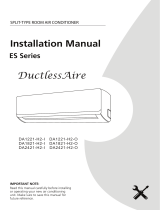
1
SAVE THESE INSTRUCTIONS!
Important Safety Information
READ AND FOLLOW ALL SAFETY INSTRUCTIONS
SAFETY PRECAUTIONS
Incorrect installation due to ignoring instructions
can cause serious damage or injury.
• When connecting refrigerant piping, do not let
substances or gases other than the specifi ed
refrigerant enter the lines as this will lower the
unit’s capacity and can cause abnormally high
pressure in the refrigeration system, which can
lead to explosion or injury.
• Installation must be performed by a certifi ed
HVAC technician. Defective installation can
cause water leakage, electrical shock or fi re.
• In North America, installation must be performed
in accordance with the requirement of NEC and
CEC by authorized personnel only.
• Contact an HVAC technician or the sales agent
for information on repair or maintenance of this
appliance.
• Only use the included accessories, parts and
specifi ed parts for installation. Using non-
standard parts can cause water leakage,
electrical shock, fi re and can cause the unit to
fail.
• Install the appliance in a fi rm location that can
support the unit’s weight. If the chosen location
cannot support the appliance’s weight, or if
the installation is not completed properly, the
appliance may fall and cause serious injury or
damage.
• For all electrical work, follow all local and
national wiring standards and regulations and
this manual. You must use an independent circuit
and single outlet to supply power. Do not connect
other appliances to the same outlet. Insuffi cient
electrical capacity or defects in electrical work
can cause electrical shock or fi re.
• For all electrical work, use all specifi ed cables.
Connect cables tightly and clamp them securely
to prevent external forces from damaging the
terminal. Improper electrical connections can
overheat and cause electrical shock or fi re.
• All wiring must be correctly arranged to ensure
that the control board can close properly. If the
control board cover is not closed properly, it
can lead to corrosion and cause the connection
points on the terminal to overheat, catch fi re or
cause electrical shock.
• In certain functional environments, such as
kitchens, server rooms, etc., the use of specially
designed air conditioning units is highly
recommended.
• This appliance is not intended for use by persons
(including children) whose physical, sensory or
metal capabilities may be different or reduced, or
who lack experience or knowledge, unless such
persons receive supervision or training to operate
the appliance by a person responsible for their
safety.
• Do not install the appliance in a location that
may be exposed to combustible gas leaks.
If combustible gas accumulates around the
appliance, it may cause fi re.
• Do not operate this appliance in a wet room
such as a bathroom or laundry room. Too
much exposure to water can cause electrical
components to short circuit.
• The appliance must be properly grounded or
electric shock can occur.
• Install drainage piping according to the
instructions in this manual. Improper drainage
may cause water damage.
NOTE ABOUT FLUORINATED GASES
• This appliance contains fl uorinated gasses. For
specifi c information on the type and amount of
gas, refer to the relevant label on the appliance
itself.
• Installation, service, maintenance and repair of
this appliance must be performed by a certifi ed
HVAC technician.
• Uninstallation and recycling must be performed
by a certifi ed HVAC technician.
• If the appliance has a leak detection system
installed, it must be checked for leaks at least
every 12 months. When the appliance is
checked for leaks, proper record keeping of all
checks is strongly recommended.




















